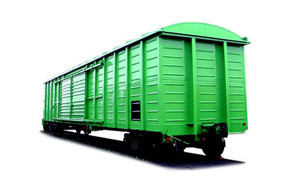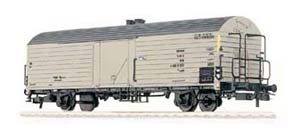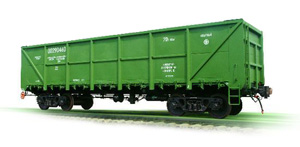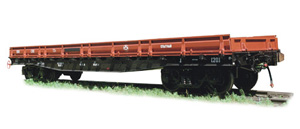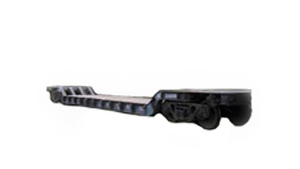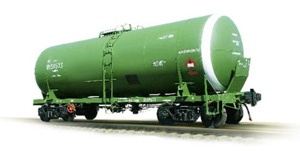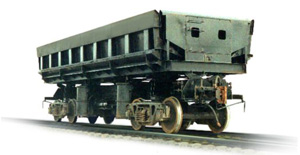Car is a unit of railway rolling stock. The car is designed to carry cargo or passengers and is equipped respectively with all the necessary appliances for their transportation, and for the car inclusion in the train.
Important parameters characterizing the possibility of using rail cars are as follows: load, container, number of axles, body space, floor space, linear dimensions of the railroad car, as well as the maximum allowable speed of movement.
Railroad car capacity means the heaviest load permitted for carriage in that car. Modern universal four-axle rail cars have a carriage capacity 68-71 ton, eight-axle 120-132 ton; the capacity of a specialized railcar is determined by the type of cargo transported. Thus, the load capacity of autorack for the transport of cars is only 20 ton, and the carrying capacity of 32-axle articulated transporter reaches 500 ton.
Different Types of Cars:
Boxcar
Capacity: 25-72 ton.
Boxcar is a type of cargo car covered from all sides. Boxcar is designated for securing the cargo transported against inclement weather conditions, theft, and mechanical damage. This type of rolling stock is used for the transport of packaged general cargo (paper, furniture, tires, beverages, canned goods).
Types of boxcars:
-
General purpose boxcars are designated for the transport of packaged general cargo, unit and bulk cargos. By applying special devices can also be used to transport people.
-
General purpose boxcars are designated for the transport of livestock and poultry, cars, paper rolls, cold-rolled steel coils and bundles, apatite concentrate and other goods.
Refrigerated boxcar
Refrigerated boxcar is designed to transport perishable freight and is equipped with appliances to maintain certain conditions for the storage of foods, such as meat, fish, fruits, vegetables, etc.).
Gondola
-
Capacity:
four-axle 22-75 ton, eight-axle 69-130 ton.
Gondola is a rail car without roof with high side walls designated to carry cargos loaded from above, such as bulk cargos, pipes, timber, wood, as well as containers and other cargoes that do not require protection from precipitations. Absence of roof allows to load/unload the gondola with ease. Hopper (kind of gondola) has angled drop-bottom hatches or chutes, or the gondola may have solid body without openings.
Flatcar
Capacity 70-73 ton.
Flatcar is an open rail car designed for transporting large and oversize cargos, and various machinery (tractors, excavators, buses), containers and equipment that are not subject to damage from the elements.
Flatcars are divided into general-purpose (for transportation of a large range of cargos) and specialized (for a certain type of cargo).
-
General-purpose flatcars have a strong steel welded frame with wooden or wood and metal decking floor and folding metal side and end boards. Flooring platform is reinforced by additional beams of the frame. End side in the open position serves a crossing for the wheeled vehicles to enter the flatcar. Flatcar is able to carry cargoes both with evenly distributed weight and the weight concentrated in the middle (45 ton on a 3-meter long car and 60 ton on a 4.3-meter long car).
-
Specialized flatcars do not have boards and some do not have flooring. They are equipped with devices for convenient securing of cargo during transit and for easier loading and unloading operations. Specialized flatcars include cars for transportation of large containers, timber, and automobiles (double-deck).
Schnabel car
Schnabel car is a specialized type of long railroad freight car with low gravity center. It is designed to carry heavy and oversized loads (such as heavy-duty transformers, parts of hydraulic turbines, stators and rotors of generators, columns, frames) that cannot be transported by other cars due to their weight and/or size.
There are following types of Schnabel cars: platform, flat, depressed cars, connected, and articulated.
-
Platform Schnabel cars
have the main load-bearing beam in the form of a curved bar at the lower part of which the loading area is located. Main beam is equipped with pivots (usually spherical), relying on the auxiliary (connecting) beams or directly on the chassis of the car. Schnabel cars capacity ranges from 55 to 220 tons (subject to the number of axles, length of load platform and its height above the rail head).
-
Flat Schnabel cars
differ from the Platform Schnabel cars by the straight form of the main beam (frame).
-
Depressed Schnabel cars
have the main carrier beam, which in the middle car forms a depression (well) between the two lateral elements. In the lower part of the depression are movable beams for supporting the cargo. Depressed Schnabel cars have the capacity from 60 to 120 tons.
-
Connected Schnabel cars
consist of two bearing platforms (parts) with arms for supporting and securing of long heavy cargos and middle platforms serving for the extension of length and connections of the car parts. Car parts are connected by shortened couplers without absorbing devices. Main types of Connected Schnabel cars are the 12-axle car (capacity 120 ton), 16-axle car (240 ton) and 32-axle car (480 ton).
-
Articulated Schnabel cars
consist of two parts with main carrying elements in the shape of brackets which through an assembly of beams rest on the chassis. The cargo is placed between the two brackets usually on the auxiliary bearing beams (sometimes without them). At the bottom the cargo (or supporting beams) is connected to brackets with lugs and rollers. At the top the cargo (or beams) is pinched between the brackets ends by gravity. Articulated Schnabel cars are equipped with hydraulic equipment that will either lift or horizontally shift the load during separation of the car parts. There are 16-axle cars (capacity 220 ton), 20-axle (300 ton), and 28-axle (400 and 500 ton).
Tank Car
Tank Car is kind of railway rolling stock designed to transport liquid commodities, oil and oil products, chemical and aggressive liquids (acids, leach, and other composite substances), liquefied gas (propane-butane, oxygen), water, milk (milk car), molasses. Tank cars are also used for carrying flour and cement.
Tank car differentiation:
-
By type:
general purpose: for transportation of oil products
specialized: for certain types of cargo
-
By design:
tank cars with frame
tank cars without frame
-
By number of axles:
4-axle
8-axle
-
By capacity
60 ton
120 ton
125 ton.
Hopper
-
Capacity:
up to 180 tons.
Hopper car is a dump car used for carrying bulk cargos (coal, ore, soil, sand, gravel). Main advantage is that it does not require specially equipped unloading sites.
